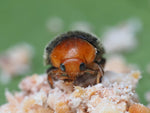Subscribe and save 10%!

Woolly ladybugs
228 SEK
Unit price perExpected delivery date: 20 December to 27 December.
Applies to orders within Sweden. For other countries - see our delivery terms .
Out of stock
Meddela mig när produkten finns i lager:
Share
Beneficial organisms for controlling wool lice. In packs of 25 or 100.
The product cannot be ordered during the winter.
Orders placed by Sunday evening will be shipped the following Tuesday.
Both adults and larvae of the woolly ladybug, Cryptolaemus , eats all species of mealybugs. It is commonly used in biological control on citrus trees and ornamental plants. The adult ladybug is about 4 mm long and the larva is slightly larger. The larva is very similar to the mealybug larva. The brown-black adult ladybug lays its eggs between the mealybugs, and they hatch after about 8 days.
Woolly ladybugs thrive best at temperatures of about 20 degrees or more, and at a relative humidity of about 60% or higher. At temperatures below 20 degrees, golden-eyed dragonfly larvae ( Chrysoperla ) are recommended instead, to control woolly aphids.
If the plant is treated with chemicals, this can harm the ladybugs.
User manual
Open the jar near the infested plant and place the jar next to the plant. It is best to carefully remove the paper strips from the jar and place them on the leaves near the mealybugs. It is also possible to use a paintbrush and carefully brush the ladybugs off the leaves.
The adult ladybugs can fly. They will be somewhat confused after release and want to fly away. To prevent this, you can release them in the dark, which makes them calmer and less likely to fly. If you want to further ensure that they stay on the plant, you can wrap the plant in a fine net or similar.
Storage
Put the ladybugs out the same day they arrive. If that is not possible, store at 15-20 degrees in the dark for a maximum of two days.
Supplied in packs of 25 or 100.
- Choosing a selection results in a full page refresh.
- Opens in a new window.






